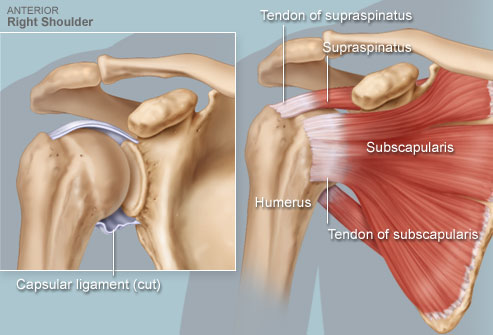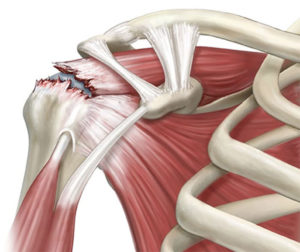 What is a Rotator Cuff?
What is a Rotator Cuff?
Your shoulder’s anatomy includes three bones from the upper arm, shoulder blade and collarbone. The upper arm bone fits into the socket of your shoulder blade creating a joint that can move and flex. The rotator cuff holds your arm in the shoulder socket, and is a group of four muscles and tendons stabilizing the shoulder joint in general. These muscles and tendons allow you to lift and rotate your arms. Though what happens when the rotator cuff gets injured or a tear?
Rotator Cuff Injury
Rotator cuff injuries are quite common, affecting more than 3 million Americans each year. It’s particularly prominent in sports or jobs with a great degree of arm rotation and usage such as baseball, tennis, painting, or cleaning windows. The rotator cuff can have a partial tear, when the tendon is damaged or frayed but not totally torn through. The full or complete tear is the separation of the tendon from the bone, or something like a hole in the tendon. While injuries like this can happen from wear and tear, or a repetitive motion over and over, they can also be caused by a fall or lifting something too heavy.
 Torn Rotator Cuff Symptoms
Torn Rotator Cuff Symptoms
With a mild rotator cuff tear you might not even feel any pain or experience symptoms. However, if you do experience symptoms you might experience:
- Dull ache in the shoulder
- Trouble sleeping
- Pain when lifting or lowering your arm
- Arm weakness
Whether the tear is sudden or develops slowly over time, there will likely be some pain in the shoulder and arm weakness. If untreated or unnoticed the pain can worsen and you might start having more trouble lifting your arm over your head. Though even if you don’t have pain you may still experience arm weakness and other symptoms.
Rotator Cuff Diagnosis
In order to diagnose a rotator cuff tear your doctor will perform a physical examination of your shoulder, checking if it’s tender in any area or for a deformity. Another test will be of your range of motion, so your doctor will see how you move your arm in different directions and your arm strength. They’ll also want to rule out other symptoms that could be causing pain in the area like a pinched nerve or arthritis.
If it’s not completely apparent what the injury is caused by, or for further confirmation and accurate diagnosis, imaging tests are used. Imaging tests use specialized medical technology to view the inner workings of the body, such as skeletal and muscular structures. You’ve probably heard of an X-Ray, MRI, or Ultrasound machine and all of these can be used for better viewing of the rotator cuff injury.
X-rays are specifically used for viewing bones, and while the muscles of a rotator cuff won’t show up here, it can be used to rule out other injuries causing pain like bone spurs or arthritis. An open MRI machine is better suited for viewing a detailed picture of your shoulder, utilizing radio waves and a powerful magnet to put these 3 dimensional images together. Though an MRI can’t be used on anyone with metallic implants or pace makers due to the usage of a magnet. Ultrasounds images are tailored to viewing soft tissues like the tendons and muscles in your shoulder.
Medical imaging tests are extremely useful for a doctor to use in a diagnosis. Doctors are trained to use these techniques and discern any differences between a normal healthy shoulder and one suffering from a torn rotator cuff or other injuries causing problems. Images combined with a physical exam and ruling out other ailments leads to the most accurate diagnosis possible, so you receive the appropriate treatment for your condition.
Torn Rotator Cuff Treatment
It’s important to get a rotator cuff tear treated as soon as you can because the damage can become worse as the tear grows larger. You’ll also likely have a faster recovery and return to normal life faster with earlier treatment. The goal of a rotator cuff treatment plan is to reduce pain and inflammation as the muscle slowly heals and becomes stronger. You may just need a little rest, ice/heat packs and some physical therapy to start feeling better, but if the injury is more severe other treatment plans are put together by your doctor.

Guided physical therapy is almost always included in an injury like a torn rotator cuff, since you need to make the surrounding shoulder muscles stronger to prevent a future tear. Y
our doctor and a professional physical therapist can work to build an exercise and stretching routine suitable for your symptom level, and have a plan as your recovery progresses. Anti-inflammatory medication is also an aid to the recovery process since it will help with pain and discomfort as you go through physical therapy.
If oral anti-inflammatory medication isn’t doing the trick there is a corticosteroid injection that is effective and helps with long lasting pain relief. The injection is admitted into your shoulder joint, but should only be used to control the symptoms temporarily during recovery. Corticosteroids are very effective as anti-inflammatory medicine, so you should see pretty quick relief after having a shoulder injection.
How long does it take for a torn rotator cuff to heal without surgery?
Depending on the severity of the injury it can take between 2 and 4 weeks for a rotator cuff injury to heal with non-surgical treatment. If it’s a more severe chronic injury then it can be a few months before you can return to normal activity levels with your shoulder. Most of the time surgery isn’t necessary for a torn rotator cuff, but if the tendon is completely separated from the bone it might be the best course of action. Your doctor will discuss all your treatment options with you and determine your best path to recovery.


